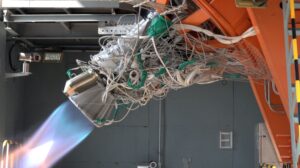Beijing-based iSpace is planning to file an initial public offering on the Science and Technology Innovation Board (STAR Market), a market established in 2019 to support tech companies.
STAR Market announced the move Jan.12 (Chinese) naming CITIC Securities and Tianfeng Securities as advisory firms.
The STIB was created to focus on companies in high-tech and strategic emerging sectors and support Chinese science and technology innovation, according to Xinhua.
Beijing Interstellar Glory Space Technology Ltd., also known as iSpace, became the first nominally private Chinese company to launch a satellite into orbit in July 2019.
The company’s Hyperbola-1 four-stage 20.8-meter-tall solid rocket sent two satellites into low Earth orbit after liftoff from Jiuquan, a national launch center.
Last year the company raised $173 million in series B round funding to back development of a new series of launch vehicles and reusable methalox engines.
iSpace is currently developing a 28-meter-tall, 3.35-meter-diameter liquid oxygen-methane launcher named Hyperbola-2.
Hyperbola-2 will be capable of delivering over 1,100 kilograms of payload into a 500-kilometer Sun-synchronous orbit, or 800 kilograms when the first stage is to be recovered and reused. The launcher’s 15-ton thrust JD-1 engine completed a 200-second hot fire test last May.
Chinese NewSpace rivals Landspace ( $175 million) and Galactic Energy ($29.9 million) also secured funding in 2020 as launch companies continue to attract interest and investment.
A 2014 central government policy shift opened the Chinese launch and small satellite sectors to private capital. Since then around 20 launch vehicle-related firms have been established in China.
These commercial launch companies are being supported by a national strategy of civil-military fusion. This includes facilitating the transfer of restricted technologies to approved firms in order to promote innovation in dual-use technology. The State Administration for Science, Technology and Industry for National Defense (SASTIND) oversees activities.
Provincial and local governments are also providing support for space companies as they look to attract high-end and emerging technology firms.
Reusable launch vehicles
Last week iSpace also announced progress in developing the reusable first stage of its Hyperbola-2 liquid methane-liquid oxygen propellant launch vehicle.
The firm carried out tests of struts for landing legs of the first stage, including structural, dynamic and vibration tests, as well as performance in high and low temperatures.
The components are designed to help absorb the impact of landing following powered descent. iSpace tested telescopic deployment arms for the landing legs in November (Chinese).
iSpace is planning to conduct hop tests, similar to those of the SpaceX Grasshopper tech demonstrator, in 2021, starting at the level of meters, followed by one-kilometer and 100-kilometer-altitude vertical launch and landing tests.
Landspace, Galactic Energy and Deep Blue Aerospace are also developing reusable liquid-propellant launchers. Landspace’s methalox Zhuque-2 is expected to make a first, expendable launch this year, before being converted for reusability.
Galactic Energy and Deep Blue Aerospace, established after early starters Landspace and iSpace, are developing their respective Pallas-1 and Nebula-2 kerosene-liquid oxygen launch vehicles.
The companies are expected to compete for domestic commercial launch contracts, as well as potential international customers. They also face competition from China Rocket Co. Ltd, Expace and CAS Space, all spinoffs from giant state-owned entities. A recent call for space station cargo proposals from China’s human spaceflight agency however suggests that involvement in civil space projects is a possibility in the future.
China’s state-owned main space contractor, CASC, is also looking into reusability. It is expected to convert the Long March 8, which had an expendable test launch in December, for vertical takeoff, vertical landing by 2025.



